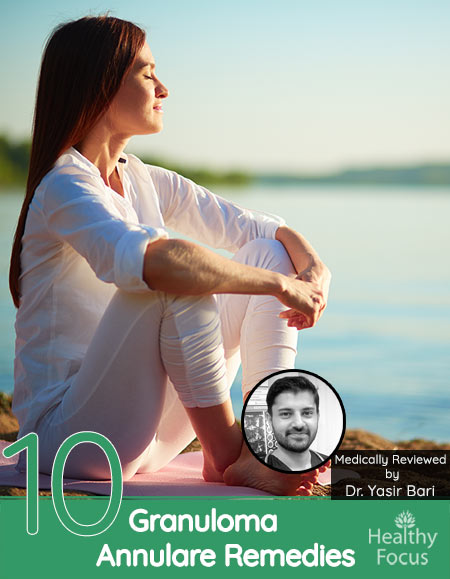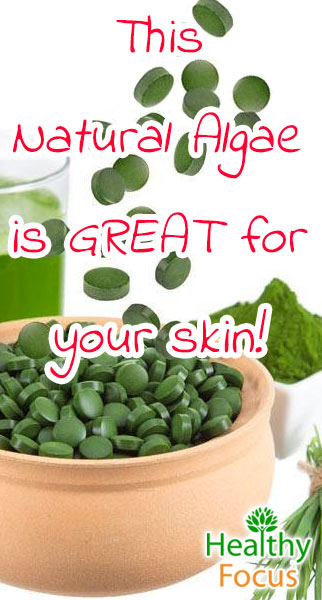Last Updated on November 25, 2019 by Marc Seward
Medically Reviewed by Dr. Yasir Bari
Bsc, (Med) Bsc, (Nutrition), MBBS, DCN (Diploma in Clinical Neurology) – Reviewed & Approved on June 09, 2019
-Written by Marc Seward
Granuloma annulare is difficult to spell but it’s actually a type of skin condition which usually occurs on the feet and the hands. The condition is characterized by raised red colored bumps or lesions which form in ring pattern.
It is not usually painful or especially itchy and will most often disappear of its own accord even without any treatment. But it can be unsightly so if you are interested in treating yours or your child’s condition then read on.
Causes and Symptoms
Like so many skin conditions, the actual cause of granuloma annulare is not fully known. It may be triggered by certain medications or by small skin wounds and abrasions. Other possible triggers are insect bites and vaccinations as well as infections such as hepatitis.
As we mentioned previously, granuloma annulare is not usually painful or irritating but the possible symptoms can vary between the different types of the condition. There are 3 variations of the condition:
Localized
Localized granuloma annulare is by far the most prevalent variety of the condition. The edges of the bumps or legions have either a circular or a semicircular shape and a diameter of up to 5 centimeters. It is more common in men than women and generally occurs on the feet and hands as well as the ankles and wrists.
Generalized
Around 15% of sufferers will develop the lesions on large areas of their bodies which includes the arms, legs and back. Unlike localized granuloma annulare, there is more chance of it being itchy and the sufferer looking for medical treatment. It is far more common for adults to develop this variety.
Subcutaneous
This type of granuloma annulare is more common in children. The subcutaneous variety develops under the skin where it creates a small firm lump around 4 centimeters in diameter.
How to treat Granuloma Annulare
Treatment is not always necessary and it should clear up on its own accord within a few months although it can take up to a few years for the condition to clear up entirely.
Conventional treatments include Corticosteroid creams, ointments or injections as well as freezing the lesion with liquid nitrogen and light therapy.
Home Remedies for Granuloma Annulare
If you would prefer to save the trip to the hospital and treat yourself at home, like eczema, granuloma annulare might respond well to a variety of similar natural remedies.
Unfortunately, other than a few small-scale studies, there is little to no research into the effects of the following home remedies on the condition. Instead, we have to rely on traditional use and personal testimony.
Having said that, the remedies that follow are extremely safe and may well work for you. They are also relatively cheap, very convenient and completely natural so why not give one of them a go?
Apple cider vinegar
Good old ACV-it seems to make an appearance in many home remedy lists especially where the skin is concerned but there is very god reason for that. It is packed with healthy minerals and has some excellent antibacterial and anti-inflammatory properties that can work on acne, eczema and psoriasis as well as granuloma annulare.
Remember that we are talking about the good quality organic, unpasteurized apple cider vinegar here. The cheap white cooking vinegar will not do much good. You can either take a daily tablespoon of apple cider vinegar orally or apply it to your skin.
- To apply it topically, soak a cotton ball in your ACV
- Apply it to your lesion and hold the ball in place with medical tape every night
- Do this until the lesion has healed up-there are many glowing testimonials to be found online but of course there are no guarantees.
Avocado paste
This is a nice natural treatment reason that avocado probably works on granuloma annulare is that it’s packed with vitamin E.
- Mash up an avocado and mix it well with sufficient olive oil so that it’s nice and smooth.
- Apply it to your lesions each day.
- Allow it to settle on your skin for at least 30 minutes before cleaning it off.
Virgin coconut oil
Like apple cider vinegar, you can either eat it or apply it to your skin. It is full of minerals and important acids that give coconut oil its wonderful skin applications. Coconut oil absorbs into the skin and penetrates very effectively – it will help soothe any itching and inflammation from your rash.
My wife loves the stuff and we even put it on our children’s skin when they have a mark of some kind. It is naturally antiviral, antibacterial and anti-fungal and will do a great job healing your lesions.
Simply rub it onto your affected skin twice each day or help yourself to a tablespoon 3 times daily.
 Aloe vera
Aloe vera
Aloe vera gel has wonderful soothing and anti-inflammatory properties that will help ease any redness or itchiness in your lesions. Aloe vera gel can easily penetrate deep into the skin and helps heal both rashes and lesions symptomatic of granuloma annulare.
If you have an aloe vera plant, simply extract its gel from a leaf and apply it to the affected area twice daily or alternatively you can buy the ready-made gel which is equally as effective.
Vitamin E
Many people have had great success treating the condition with vitamin E and research done into its effect was very promising when vitamin E was used in conjunction with zileuton.
The small scale study helped fully rid the 3 long term sufferers of their granuloma annularae within 3 months of treatment. (1)
Milk of magnesia
Milk of magnesia is a cheap and convenient home remedy for a variety of skin conditions including annoying acne. You can apply it to your affected skin with a cotton ball, then allowing it to dry before rinsing it off.
Herbal oils
Many herbs have anti-inflammatory and antibacterial qualities that work wonders on skin abrasions and rashes. Turmeric and ginger are especially well known for their health benefits and can be used as an ingredient for a paste to treat granuloma annulare. Other safe and natural herbs you could try are skullcap and boswellia.
- Take 4 teaspoons of your chosen powdered herb.
- Mix it up well with 4 tablespoons of olive oil and store it somewhere cool and dry.
- Massage it into your rash and lesions twice a day for 4 weeks.
- Turmeric has been known to turn your skin orange but it’s an excellent ant-inflammatory and should really help.
- Alternatively, you can start trying to add more of these herbs to your diet.
Tea tree essential oil
Tea tree essential oil is among the best essential oils for treating the skin. It has outstanding antimicrobial and anti-inflammatory abilities and a diverse list of benefits, which is why it is so popular.
Do not rub it into your skin before you have diluted it sufficiently with a carrier oil like olive oil or coconut oil first.
Just apply the diluted oil onto the affected area of your skin once in the morning and then again in the evening and let it do its work.
Green tea
Green tea is one of the most beneficial drinks you can consume regularly. It is an extremely rich source of antioxidants in the shape of flavonoids called catechins. Drinking green tea on a regular basis might well help you with your skin conditions as well as its myriad other benefits.
Another way to use your green tea is to apply the used bags to your skin directly. I’s antioxidant and anti-inflammatory abilities will help ease any irritation and help the healing process.
Spirulina
You could do worse than giving spirulina, a natural algae a go. It is an excellent immune system modulator which is commonly used a supplement for skin related issues. It is chock full of amino acids, important vitamins and chlorophyll.
Experts recommend a daily dose of between 2,000 and 3,000 mgs consumed throughout the day but should not be used for more than 3 weeks at a time.
Vitamin D
There is some, limited evidence that oral vitamin D may help treat granuloma annulare. A case study reported in 2012 looked at the case of a 40 year old woman with a long history of the disease. The bumps first presented on her legs before spreading to her upper torso causing intense itching.
She was treated with oral calcitriol and within just a month, the rash began to disappear and the itching had gone.
The findings were interesting but inconclusive. The study notes that two older papers had suggested that vitamin D could actually make the condition worse. (2)
Frequently Asked Questions
What triggers granuloma annulare?
As is the case with so many other skin conditions, the actual causes of granuloma annulare remain unknown. There are however believed to be certain triggers including skin trauma, certain medications, sun exposure and infections like hepatitis.
How do you get rid of granuloma annulare?
Most of the time, granuloma annilare will resolve of its own accord without the need for treatment. Medical treatments include steroid creams, cryotherapy and heat treaments. There are also a number of potential home remedies including aloe vera, apple cider vinegar, tea tree oil, vitamin E and turmeric. However, there is little research into the effectiveness of these home remedies.
Does granuloma annulare ever go away?
The condition will usually clear up without any treatment. How long the condition takes to clear up depends on various factors. For some, it can resolve within months while for others it can take as long as two years. Most of the time, the skin will clear up completely but in the case of ‘perforating granuloma annulare’, there may be some residual scarring.
Unfortunately, the condition tends to recur even after it has cleared whether or not it has been treated.
What are the risk factors for granuloma annulare.
There are certain potential triggers but experts are not in total agreement about risk factors. The following risk factors may trigger the condition :
- chronic stress
- sun-damaged skin
- infections including HIV and hepatitis
- certain medical treatments including diclofenac, calcitonin, quinidine, amlodipene and ACE inhibitors.
Final Thoughts
- Granuloma annulare is a skin condition characterized by raised red bumps in a circular shape on the skin especially in the hands and the feet.
- The bumps are often the only symptom and it is rarely itchy or painful.
- The condition usually resolves of its own accord within a few months but can take up to a few years to completely disappear.
- There are a number of home remedies that may help speed up the healing process.
- These include apple cider vinegar, tea tree oil, turmeric, vitamin E and aloe vera.
- There is very little research into the effectiveness of these home remedies but there are plenty of personal testimonies that support them.
Have you ever had this condition and did you use any home remedies to help treat it?
Please let us know what you thought of them or let us know if you have a home remedy that we have not mentioned. We can add it to our list.
(1) http://www.ncbi.nlm.nih.gov/pubmed/11966702
(2) https://onlinelibrary.wiley.com/doi/abs/10.1111/j.1365-4632.2010.04510.x



Leave a Reply
You must be logged in to post a comment.